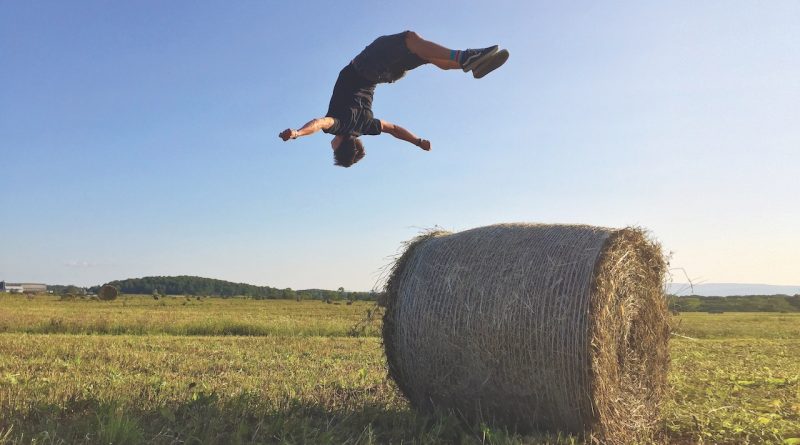The New Ninja Warriors
Vermont’s gyms are spawning a new breed of athletes, ninja warriors who are as at home launching off roofs, rails, cliffs or hay bales as they are tumbling in a gym.
It’s 9 p.m. on a Monday night and Noah Labow moves like a leopard on the hunt. He’s on all fours, scuttling along a line on the floor, hands and legs flashing quickly along a ribbon of white, less than six inches wide. He reaches the end of the line, springs forward, arms straight like Superman, and then tucks and rolls. He is weightless, graceful as a dancer, soundless. His body, as lean and ripped as a climber’s, flows from one move to the next without a pause.
Behind him, nearly two dozen University of Vermont students follow, scrambling across the mats of
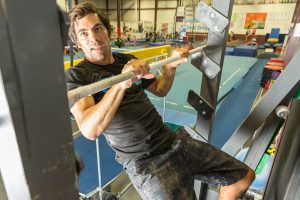
the Green Mountain Training Center in Williston. They do so with passion, varying degrees of clumsiness, and a few grunts.
Labow is 37. The students are mostly 15 to 20 years younger and members of the UVM Freeskiing Team. After warming up, they’ll take to the trampolines and foam pits, practicing corks (spinning tricks), flips, grabs and the other moves they’ll transfer to the snow this winter. Labow, a skier who has competed in pro-am big air contests, moguls, halfpipe and extreme skiing competitions, watches and works with them. “Hold your knees in,” he tells a freshman, who two weeks ago had never been on a trampoline. She tries again, and nails a corked 720.
Elsewhere around the gym, girls are practicing classic gymnast moves: handsprings, back flips, cartwheels. In another corner, there is what looks like the remnants of a movie set: A castle-like “tower,” a rack with a variety of handholds, giant blocks, mats and giant foam shapes.
On another night, you might find Labow in this corner, swinging up from a hand ring on the rack, grabbing a rope that hangs from the ceiling, swinging back to spin around a metal pole up to the top of a “tower” (a structure made to look like a castle tower) and then leaping off to land with a tuck and a roll and then a standing front flip—like Tarzan moving through a converted warehouse jungle in Williston.
This is the Ninja/parkour section of the gym that Labow calls home for much of the winter season. Seven years ago, Green Mountain Training Center was a classic gymnastics gym and Noah Labow was coaching freestyle skiing at Carabasset Valley Academy in Maine. A Johnson State College grad, he got a call to come home and coach at University of Vermont. He took the job and started training at the Green Mountain Training Center.
That was also about the time that American Ninja Warrior was in its second season and invited Olympic mogul skier Jonny Mosely to host.
“I saw the show and thought, why not?” says Labow. He put together a demo reel of himself, skiing, zip-lining, doing tricks and free running.
“I was at Copper Mountain right after a competition when I got the call inviting me to a casting call in Los Angeles the next week.” Labow made the cut and appeared on Season 5 of the top-rated show.
The New Athlete
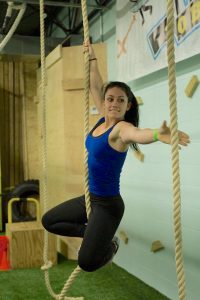
Ninja warrior, obstacle racer, parkour practitioner, free runner, freeskier—Labow, a bit of all of these, is one of an emerging breed of multi-talented athletes. “All of these sports teach you, basically, how animals move—and how humans used to move—through the landscape,” Labow says. “What we’re trying to do is to get back to that primal strength and freedom of movement.
“What I love is that there is something so free and non-competitive about this,” chimes in Isaac Marks, a 14-year-old with thick-rimmed black glasses and an already-powerful upper build. Marks, a protégé of Labow’s, has been training here since he was nine. None of his family are athletes– “they are all tech nerds,” he says.
“I love this place, I come here three or four times a week,” he says, then demonstrates a “trick” placing a hand on the floor and tumbling with a flip and a spin, around it. “It’s a great conversation starter and I just like being able to do that.” Then he adds: “But sure, yeah, I’d love to be on Ninja Warrior someday, too.”
The Ninja Revolution
The TV show, “American Ninja Warrior,” evolved from the Japanese show “Sasuke,” which challenged contestants to climb, swing and balance their way through a series of ever-more-creative obstacles. It had little in common with historic ninjas, Japanese mercenaries who in the 15th through 17th centuries ignored the time-honored customs of samurai warfare to play by their own rules. The moves in the modern version are more akin to the depictions of the superheroes in cartoons—men and women who leap off tall buildings, throw in martial arts moves and swing across urban canyons.
The show borrowed heavily from parkour, a sport that has been around since the early 1900s when a French Naval officer named George Hebert tried to create an approach to workouts that simulated the skills he saw in native African tribes.
Parkour involves running, swinging, climbing and jumping through an obstacle course. It has become as much an ethic that espouses freedom of movement using your total body as it is a workout. As its recent popularity has spread, parkour has spawned free running as well—running through an urban or natural landscape—and “tricking” (doing acrobatics) off obstacles on the way.
“If you want to see the ultimate demonstration of freerunning or parkour with guys flipping off walls, landing on stairs and all on concrete, watch the Red Bull Santorini parkour contest,” says Labow.
Since “American Ninja Warrior” premiered in 2009, the show has seen applications soar from 1,000 to more than 70,000. National Ninja League hosts qualifiers at gyms and obstacle courses around the country. In Vermont, gyms formerly focused on gymnastics, such as Green Mountain Training Center and Regal Gym in Essex, have been gradually adding obstacles, walls, ropes and ladders and outdoor centers.
Like skateboarders who trick off urban ledges, curbs or rails or skiers and riders who trick off a terrain park, these gyms and shows are spawning a whole new generation of athletes who are using both gyms and the natural world as launching pads for acrobatics.
And some of the best of these athletes are from Vermont.
Lady Mighty Mouse
Last March, at the National Ninja League showdown at the VertiQuest gym in New Jersey, McKinley Pierce beat the two top-ranked women in the nation to win the event, at the same time earning enough points to take third place overall for the season. Nicknamed “Lady Mighty Mouse” (Ninja Warriors often get nicknames) the 5’1″ dancer breezed through a course that had her bracing her feet against two walls, swinging along monkey bars, swinging from one rope to grasp a thin grab on a wall and skipping along bars set two feet apart.
Pierce, who grew up in Warren, Vt., came into Ninja Warrior competition in a round-about way. A dancer and part of the troupe that won “Vermont Has Talent” in 2013, she trained at Regal Gym in Essex Junction, Vt., (which specializes in training for American Ninja Warrior and Spartan events) and then started competing in 2016. She won her first event.
Regal is a gymnastics training site with a vast room filled with mats, bars, foam pits and trampolines. But there’s another area, an entire room dedicated to the types of obstacles to conquer with names like Walking Wind Chimes, Double Salmon Ladder, the Wobble Totter and Ultimate Cliff Hanger that focuses on Ninja tricks.
“I love the fact that this gym has so many really creative obstacles in a small room,” says Pierce, who is one of a few women in Vermont doing Ninja training. “It takes a lot of upper body strength and a lot of balance and every technique comes down to how you move your body. It never feels like working out, it’s just fun.”
After earning $500 last season, this season, Pierce is going for the $2,000 first prize and is applying to be on the TV show American Ninja Warriors.
Going Pro as a Stuntman
While there’s no real pro circuit for Ninjas, the training can lead to other lucrative careers.
“I love the fact that I can make a living doing all the sports I love to do at once,” says Justice Hedenberg, a skateboarder, freeskier, free-runner, martial arts practitioner and gymnast from Hinesburg, Vt. When he’s in Vermont, Hedenberg helps out coaching at Green Mountain Training Center teaching parkour.
But when I reached him by phone, the 25-year-old was in Los Angeles, waiting at a casting call for a movie role as a stuntman. Hedenberg has already played a National Guardsman in Ghostbusters (2016), done fight scenes in the Netflix series Daredevil, crashed through a table while fighting Donnie Wahlberg’s stunt double, cartwheeled his way through a Verizon commercial and been catapulted (literally) on-stage to land on a skateboard while touring with Marvel Universe Live. “That last one was a little scary,” Hedenberg admits.
Hedenberg’s father, Todd, was the freeskiing coach at Mad River Glen and growing up he skied, but it was his mother, Elizabeth Deutsch, who pushed him to get into gymnastics and to go to Circus Smirkus’ youth circus arts program. “I learned a lot of balancing tricks there—like balancing chairs and perching on poles.”
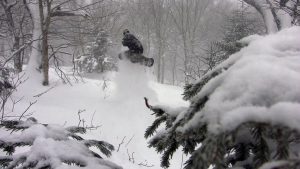
At 13, Hedenberg started training with a Czech gymnastics coach, Stefan Hruska “He’s the one who really taught me a lot about how to move your body,” says Hedenberg. “He was this jolly, happy guy who understood that gymnastics was not just about competing but applying what you learned to other sports. He would always tell me, in his thick Czech accent: “You need more explohshion, more explohshion.”
Hedenberg began taking what he learned in gymnastics and martial arts and applying them to skateboarding. His demo reel shows him riding up a bowl in a ramp, leaping, then landing on a second skateboard, four feet from the lip and skating away (a move which earned him airtime on the website/social media empire, PeopleAreAwesome.com.) Recently, he perfected going up a skateboard ramp, doing a double aerial flip with a spin — a “Rudi,” in gymnastics terms — and landing on the ramp’s top lip.
“It’s amazing how things are progressing. I look on the Internet and am blown away by what I see kids doing today. When I was a kid. It was crazy to do a 540 — a spin and a half. Now, if you can’t do two flips while spinning and still land, you’re chump change,” says Hedenberg.
Still, one of his favorite things to do is teach other kids and he does so at GMTC when he’s back in Vermont. “I love it when someone who is waist-high sees me do a trick and comes up and says, “whoooaa, I wish I could do that,” and I look at him or her and say, “yeah, you can.”
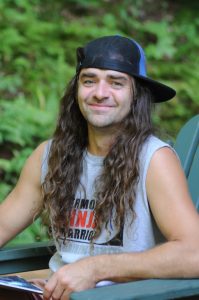
Taking it Back to Nature
When Chris Tower was a kid, he was told he might never walk without leg braces. Today, he’s an American Ninja Warrior instructor at Regal Gym and one of the instigators in bringing Ninja training to Vermont.
Tower was born with Legg–Calvé–Perthes disease (LCPD). He was told he’d never be able to run, ski, ride bikes or even walk without leg braces, but at age 5, he kicked them off and set out on a bike. He later took up skiing and then snowboarding. “I was a little like Forrest Gump,” says Tower, now 36. “Once I got out there, I just kept going.”
Tower fell in love with snowboarding and started competing regionally. “I built my own terrain park in my backyard,” he says. He tricked off anything he could find, improvising and filming a lot of his moves with his amateur film crew, Green Mountain Rippers. The films show him taking hits off trees, flipping off rocks, using fallen tree trunks like rails. He rides backcountry terrain the way other riders use a terrain park. His most recent release “Through My Lens” (2016) tells his story and shows his unique style of riding through the tight backcountry trees and the gnarliest terrain of Mt. Mansfield’s western slopes.
One year, judging from his pedometer, Tower estimates he logged 1,500 miles snowshoeing up to snowboard down. And that was before he got a splitboard. “I haven’t bought a lift ticket in 13 years,” he says proudly. “It’s all human powered.”
When his mother and stepfather opened Regal Gym, Tower saw an opportunity. “There were a ton of kids, mainly little girls, who wanted to do gymnastics there,” he says. He saw a chance to bring in a new type of aspiring athlete, the Ninja Warrior, and worked to set up the Ninja Warrior room and training at the gym.
Gradually, the gym has added different obstacles to its training room and increased its training schedule. “It’s still mainly kids, but we’re starting to get some adults coming into train as well,” says Tower. He and McKinley Pierce are two of the primary trainers.
But for Tower, the gym is just the practice site. The real tricks are to be done out in nature, away from the crowds, somewhere in the backcountry.
“Riding is what makes me happy,” Tower says, simply. “Life’s too short to be serious. Why not ride every day you can?”

